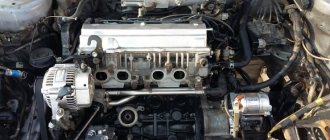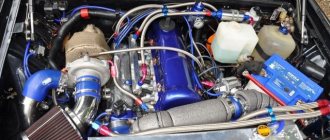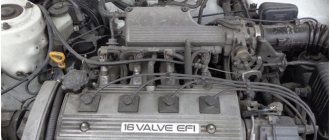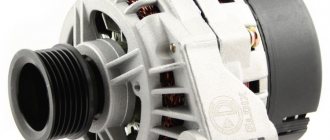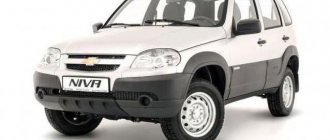A rainbow of different bottles are offered on the shelves in an auto store: dozens of markings, brands and approvals.
How to find out what exactly your car needs: antifreeze or antifreeze, red or green, Mobil or Polarnik?
If the instructions for your car indicate a clear specification: for example, Ford WSS-M97B51-A1, aka BASF Glysantin G05, aka Mazda 0000-77-507E-02, then there is no problem. Look for the treasured jar (canister) with a similar tolerance, and don’t bother with the color, the question “what’s in it, what’s in it?”, and taking a taste test: sweet or not.
Why was a branded coolant (from the car manufacturer) used as an example, or a product from a well-known chemical concern? Because the packaging contains the main characteristic for the buyer: the car manufacturer's approval for a specific car (as in the technical service instructions). This means that this antifreeze or antifreeze can be poured into the radiator, and at a minimum it will cool well, and at a maximum it will not harm your car.
Coolant functions
Before choosing a specific type of antifreeze, you should pay attention to the functions that the liquid performs. Everything here is not as simple as it seems. The list is extensive:
- direct cooling of the power unit in order to maintain optimal operating temperature and prevent excessive wear of key elements;
- protection of metal parts of the cooling system from the formation of rust and scale, as well as the occurrence of cavitation - water hammer;
- Pump lubrication to extend service life and maintain efficient operation.
How to choose and which antifreeze is the best?
Now the question has arisen: how to choose antifreeze. There are already so many varieties of them in any store that you can go crazy until you understand which one you need. And the neighbor in the garage advises one thing, and the salesman in the store advises another... Where to run?
Run home, find your car’s service book and read what the automaker recommends. As a rule, the requirements for antifreeze specifications are clearly and unambiguously stated. This is the only source of truth, since even for the same car models, different antifreezes may be recommended, depending on the configuration. So you can thank your neighbor for his advice, but do as the car manufacturer recommends.
A lot depends on whether the antifreeze is chosen correctly: how quickly the engine will warm up and how effectively it will cool, how the liquid will interact with the metal of the radiator and engine, how the elastic seals will behave.
If there is absolutely no service book, you can select antifreeze according to the approval sheets from the car manufacturer. This is also a good way to find the right liquid and not make a mistake.
After the situation with the approval and specification of antifreeze has become clear, you can choose a brand. And here it is better to pay attention to high-quality antifreeze brands that have long proven themselves in the world market. The same Swag or Hepu have earned a reputation as reliable manufacturers of auto chemicals, whose products are always worth the investment.
You can, of course, take a risk and purchase products from some little-known company if there are good reviews about it from fellow car enthusiasts. But you will have to regularly “keep an eye” on such antifreeze: is there any foam in the expansion tank, is there any sediment appearing, is the color changing, etc.
Well, the most luxurious option would be original (OEM) antifreeze. Yes, it is quite expensive, but this is a guarantee of high quality and long service life!
About the components that make up the coolant
It is known that all antifreezes for cars have different colors. They may well have red or green shades. However, their compositions look something like this:
- the main substance is usually propylene or ethylene glycol;
- distilled water - its share is very small;
- dye - the appearance of antifreeze depends on it;
- a variety of special additives that play a key role in this whole story.
Additives used in the manufacture of antifreeze
So-called additives directly affect the properties of the coolant, what the antifreeze will be and its characteristics. Previously, manufacturers used traditional substances that many now consider obsolete: phosphates, nitrites, amines, silicates, borates and others. The main problem is that they can release gel, abrasive and sediment, which negatively affects the condition of the cooling system and reduces its service life. But there is also a carboxylate type of additives, which are made with the addition of salts of carboxylic acids. Other additives may include antifoaming and anticorrosive agents. Interestingly, in this case, the coolant acts specifically on rust spots and forms a protective film in specific areas. This allows you to save antifreeze consumption.
Which is better: antifreeze or antifreeze?
This is one of the most common questions among car enthusiasts. Is it possible to pour antifreeze into your favorite Fordik, or maybe it’s better to buy good antifreeze for your “penny”? We answer.
In fact, antifreeze is the name given to any coolant, both for cars and other equipment. So the water poured into the cooling system is also “antifreeze” for its purpose.
However, it so happens that we call all car coolants antifreeze. And among them you can find canisters with the inscription TOSOL, which only means the brand of antifreeze. In terms of its composition, it is a mixture of ethylene glycol, water and mineral additives, according to the classification - first generation mineral (traditional) antifreeze, according to the VW specification - group G11. And it is used exactly as all other mineral antifreezes of the G11 class are used: for cars produced before 1996, with brass or copper cooling and heating radiators, with a cast iron engine “jacket”.
Most often, Antifreeze is bought for used domestic cars, since it was originally developed for them, and it is for them that it is the best antifreeze.
What happens if you “pamper” an old car with a higher class coolant? Perhaps nothing. But if, for example, a brass “stove” is installed in the car, good quality antifreeze G12+ or G12++ will corrode it in a short time. Simply because it is not suitable for this metal.
The answer to the question “which is better?” There can only be one: the best antifreeze is the one that is suitable for the car. And if you need Antifreeze, then fill it with Antifreeze!
About antifreeze labeling
Of course, the choice of a specific product directly depends on the manufacturer’s recommendations. They can be easily found in the car's owner's manual. It is also believed that liquids of different colors should not be mixed due to the fact that they may contain different additives. Their combination can negatively affect the overall effectiveness of antifreeze. What definitely deserves the attention of a car enthusiast is the labeling of a particular type of product used to work in the cooling system.
G11
. A budget antifreeze that has good lubricating properties and contains additives against the formation of foam and rust. The coolant is of inorganic origin and contains nitrates and phosphates. Antifreeze G11 is produced using silicate technology. Additives cover the entire surface of the cooling system - both areas affected by corrosion and areas without rust. A layer of additives protects existing corrosion areas from further destruction. Coolant of this class is characterized by low stability, low heat transfer and short service life. After this period, G11 antifreeze precipitates in the form of solid particles that have abrasive properties and can harm the internal surfaces of the cooling system. This composition is not suitable for cooling the engines of modern cars equipped with radiators with thin channels. G11 is not suitable for radiators and blocks made of aluminum.
G12
. A carboxylate product with high corrosion resistance. Well suited for engines operating at high temperatures. Compared to G11, G12 antifreeze has a longer service life - from 4 to 5 years. The product is a homogeneous transparent liquid, usually red or pink. The coolant contains ethylene glycol with the addition of two or more carboxylic acids. Antifreeze G12 does not form a protective film, but acts on emerging areas of corrosion. Thanks to this, the liquid removes heat better, and the additives work less intensively. The composition is well suited for cars with an aluminum block and radiator.
G12+ and G12++
. There is also G12+ antifreeze, made using hybrid technology, which combines silicate and carboxylate production methods. In 2008, G12++ antifreeze appeared, which combines an organic base with a small amount of mineral additives. This technology is called Lobrid, or SOAT coolants. In antifreezes G12+ and G12++ we managed to get rid of the main disadvantage of G12 - the ability to eliminate rust only when it has already appeared. Hybrid compositions have a preventive effect on washed surfaces in order to prevent the occurrence of corrosion.
G13
. Non-toxic, made on the basis of propylene glycol, dissolves well in water and is practically not aggressive towards the environment. Antifreeze G13 appeared on the lubricants market in 2012. The fundamental difference between this type of product and all previous ones is its environmental friendliness: instead of a toxic ethylene glycol base, this type of coolant uses harmless and environmentally friendly propylene glycol. In terms of its performance characteristics, G13 antifreeze is close to G12+ and G12++.
Is it possible to mix antifreeze?
Mixing antifreeze is one of the most interesting topics of discussion. Considering that antifreezes are marked not only by specifications, but also by color, the issue of mixing has acquired a touch of shamanism. In the video above, the popular program has its own compelling arguments.
The reason for the disagreement is that until a certain time, manufacturers painted antifreezes the way their imagination told them. Therefore, car enthusiasts of the “old guard” are accustomed to the fact that color does not affect anything.
However, recently the picture has changed: by mutual agreement, the color of the antifreeze indirectly indicates its specification, which means it can also serve as a guide for those who want to “prepare a cocktail.”
If it is urgently necessary to add coolant to a cooling system that already has liquid, you need to navigate as follows:
- G11 should absolutely not be mixed with G12. Their additives operate opposite to each other and can cause unpleasant consequences. But it works quite well with G12++. And, of course, you can mix antifreezes of the same specification, but in different colors (for example, blue and green G11);
- The situation is much the same with the newest G13. It can be yellow or purple, and within the same specification they can be mixed without problems; with G12, G12+ and G12++ it is also acceptable, but with G11 it is better not to interfere;
- Well, G12, G12+ and G12++ are mixed with each other without any special consequences. You just need to remember that if you add antifreeze of a lower class to an antifreeze of a higher class, then all the antifreeze will lower its class, so we do not recommend doing this.
Table of compatible antifreeze types
And yet: why do you need to mix antifreeze? If the coolant level drops while on the road, and you don’t have the necessary product on hand (or on sale at the nearest gas station), you can simply add a little distilled water to the system. Ready-made antifreeze already consists of half water, and ethylene glycol boils at 120 degrees, so a little dilution won’t do any harm. “On the water” you can even get to a service station if a leak has formed in the cooling system and urgent repairs are needed. It's still better than mixing two liquids that contain secret ingredients. No one can predict what chemical reaction will occur between them!
Other important characteristics
Let's say you evaluate the composition of antifreeze and trust its manufacturer. It would be useful to pay attention to other equally important technical characteristics of this liquid. In particular, the temperature at which the “coolant” begins to boil or solidify. These operating ranges are directly dependent on the specific product class. If we talk about budget options, they can boil already at a temperature of 109 degrees Celsius. More expensive options can withstand even high temperatures of 125 degrees. In terms of resistance to sub-zero temperatures, antifreeze can usually withstand even extreme negative temperatures of minus 40 degrees.
Technical characteristics of antifreeze
The characteristics of finished antifreeze depend on the concentration of the active substance (ethylene glycol or propylene glycol) in water, as well as the properties of the additives.
Temperature indicators
Ethylene glycol in its pure form freezes at only -13 degrees. However, when mixed with water in a ratio of 60:40, it produces a solution that freezes at -49 degrees. This property makes it suitable for use in harsh winter conditions.
The boiling point of ethylene glycol is 197 degrees and decreases when diluted with water. Ready-made antifreeze boils at 120 degrees, and this is quite enough even for a powerful engine.
Propylene glycol in solutions behaves completely differently: the pure substance freezes at -60, and a solution with water in a ratio of 60:40 freezes at -54 degrees. The boiling point decreases just as smoothly, and from 187 degrees for pure propylene glycol drops to 135, which is slightly higher than that of ethylene glycol compounds.
But Antifreeze already boils at 105-110 degrees, but can withstand frost down to -65.
Density
The density of antifreeze is mainly of interest to specialists who service equipment. As a rule, car owners are advised to monitor the fluid level in the cooling system, add antifreeze as needed and change it on a schedule.
However, density is directly related to such an important characteristic as the “Prandtl number”. This is a measure of how quickly a liquid can remove heat. The higher the density, the higher the Prandtl number, which is why it also sometimes has to be measured. In addition, the freezing point of the coolant depends on the density. That is, sometimes it will be useful to know whether the liquid that is poured into the cooling system is suitable for the winter period. And what did the servicemen “cheat” on us...
Non-compliance with the stated characteristics
In some cases, antifreeze can let the car owner down, failing to cope with its responsibilities. In this case, operating conditions may comply with the instructions. Why is this happening? There are at least two reasons for this:
- The product may be of poor quality or even counterfeit. In this situation, it will probably be possible to find substances in the composition that reduce the quality of the glycol base, as well as cheap analogues of additives. Such a concentrate can seriously damage the cooling system.
- The possibility of a vehicle malfunction should not be ruled out. Breaks in sealed connections often lead to microparticles getting into the antifreeze, which negatively affect its properties.
About color
This is a controversial issue, there are many disputes and legends about it that supposedly all reasoning is deceptive. For example, you can pour red antifreeze into green antifreeze and nothing will happen! And color is just a marketing ploy! As I already wrote above, antifreezes are specially tinted so that you know what additive is present in it, carbonic acid, hybrid, ordinary traditional or some other.
Also, many do not want to delve into such information - not all cars have a similar cooling system, I mean the metal from which it is made, some have brass or copper in their structure, others have aluminum. For example, carbonic acid additives (red color) perfectly protect copper and brass, but they corrode aluminum. But hybrid additives (green color) perfectly protect aluminum, but not so well copper and brass.
Therefore, guys, we pour what is written in your car manual! There is no need to engage in amateur activities; read more about the differences between green, red and blue antifreeze here.
Antifreeze service life
Like any other technical fluid created for use in automotive systems, the “coolant” must be changed and also topped up if necessary. How can you tell if the engine cooling solution has lost its properties? Firstly, the car itself can signal this if it is equipped with the appropriate sensor. Secondly, you can notice that the operating temperature of the power unit has increased significantly and has not returned to its usual values for a long time. Finally, you can look at the condition of the antifreeze. If it has acquired a brown tint, reminiscent of rust, you should think about replacing it immediately.
Advantages and disadvantages of antifreeze
Like everything in this world, antifreeze has its pros and cons. They must be taken into account when choosing, using and disposing of coolant so as not to harm your car, yourself, the people around you and nature.
Benefits of antifreeze.
- The main advantage of modern coolants is their additional properties. This is protection against corrosion, restoration of the elasticity of rubber gaskets and seals, and lubricating properties. And compared to ordinary water, antifreeze also copes well with high and low temperatures.
- Another advantage of glycol-based antifreeze is its low coefficient of expansion during freezing. It's not scary to leave your car in the cold: even at very low temperatures, not a solid block of ice forms in the cooling system, but small crystals.
- And finally, the ability to change physical characteristics by simply changing the concentration makes this remedy very convenient for residents of the northern regions.
Disadvantages of antifreeze.
- The main disadvantage is the danger to people and nature. Ethylene glycol is a dangerous poison, the lethal dose of which for an adult is only 100 ml. It is clear that no one in their right mind would drink antifreeze, but there are still children and pets to whom you cannot explain that this red, sweetish liquid is not juice, but poison. The baby only needs a second to take a couple of sips; the puppy can chew on the canister while the owners are sleeping. Therefore, you should store the antifreeze container out of the reach of children. Literally!
- The second thing to remember: used antifreeze cannot be poured down the drain, onto the ground, into water bodies, etc. It does not decompose, but penetrates into groundwater and poisons it. It is best to take the canister with drained antifreeze to a service station, which hands it over for recycling. By the way, this is why manufacturers came to use more expensive, but also safer propylene glycol. Perhaps over time it will become the main component of all antifreezes.
How to check the coolant level
If we are talking about simply adding antifreeze, then it is important to follow safety precautions. It is known that the operating temperature of the engine can be very high, so you should allow it to cool before checking the fluid. This is also important because hot antifreeze circulates in the system, and even a specialist will not be able to estimate its exact amount under such conditions. As a rule, the best option is to check after overnight parking - this way the readings will be as correct as possible. There are two marks on the expansion tank indicating extreme levels of antifreeze. It's good if you manage to maintain average performance. An important point: if you decide to add water rather than coolant, it is better to use a distilled product.
General composition of antifreeze
Whatever one may say, all antifreezes, be it red - green or blue , consist of 80% of almost the same thing:
- Ethylene glycol (monoethylene glycol, ethanediol, etc.) is a simple diatomic alcohol, oily consistency, practically odorless, slightly viscous, if you measure the density, it is 1.112-1.113 g/cm3 (if measured at 20 degrees Celsius). The boiling point is 196 ° C, but it freezes at - 12, - 13 ° C (therefore, it must be diluted with water). When heated, it expands greatly, so about 10% less is poured into the system when it is cold.
- Water . It is MANDATORY necessary, otherwise pure “glycols” will freeze at -13 °C. Distilled water must be used so as not to cause scale on the walls of pipes and radiators.
- Additives . These are mainly anti-corrosion - they are divided into four types: - lobrid, carbonoxylate, hybrid and traditional.
This is the main composition of antifreeze, if everything is clear with the first and second points, then the third point (additives) needs additional explanation.
What to do if the antifreeze needs to be completely changed
Let's say you decide to change the coolant yourself. To do this, you will first need to drain the used product. You should park the car on a relatively level area and cool the engine to avoid burns during operation. Next, you need to remove the crankcase protection, if necessary, and also prepare containers for processing. After draining the old fluid, you need to flush the system and pour new antifreeze in a thin stream. This is a fundamentally important point - if you pour it too actively, you can get unpleasant surprises in the form of air pockets formed. They can interfere with the operation of the cooling system.
You may be interested in: Boiling points of antifreezes of different colors
Features of blue antifreeze
You can select the coolant based on its parameters and their interaction with the radiator material. This antifreeze works best on aluminum, effectively protecting it from corrosion and rapid wear. In addition, you need to consider how often the car is used and at what power it operates. Class G11, which includes blue antifreeze, is designed for constant and heavy engine loads. This is what accounts for such a high number of protective additives in its composition.
What to pay attention to. The shelf life of blue antifreeze is lower than that of G12 class fluids. It is about 3 years, but may vary slightly depending on the manufacturer. With constant use, the antifreeze decomposes quite quickly, and its boiling point can lead to the formation of foam and boiling off of the antifreeze when driving at high speeds and speeds. But its crystallization temperature reaches -40 degrees, so it will withstand work even in severe frosts.
Color. The finished product has a transparent or light color, so it is painted in different colors, depending on the brand and the characteristics of the composition. Two antifreezes of the same class, but different in parameters, from the same company may have different shades to make it easier to distinguish them. A bright blue, cyan or turquoise color will make it easy to notice a leak in the cooling system and understand that you need to contact service.
You may also be interested
Antifreeze Sintec G11 / Euro G11 green: description and properties
The correct choice of this fluid determines how long you can use the car without replacing the cooler and how well it will protect the car. SINTEC G11 Euro is a product that meets modern requirements.
High-quality antifreeze is a guarantee of safe operation of your car
Antifreeze refers to the coolant necessary for the functioning of a car engine. Antifreeze allows you to cool the structural components of a car engine to the required temperature, preventing their deformation and failure. Before the invention of antifreeze, ordinary water was used as a coolant, but the water circulating in the cooling circuit tended to freeze, and when it freezes, the water increases in volume. Water expansion […]
What is antifreeze, what is its composition and what is it for?
Composition of the coolant
The very first and most important purpose of antifreeze is to act as a coolant in the engine cooling system. Passing through the cooling jacket, the antifreeze absorbs some of the heat generated by the engine during operation. Then it goes into the cooling radiator and cools down there under the influence of a counter flow of air or with additional airflow from a fan. And - again to the engine. Such a closed system can work for quite a long time if there is no damage to it and if it is properly balanced.
Yes, but plain water could do the job! Why, then, use special mixtures, compare compositions, and select suitable ones?
The answer lies in the chemical and physical properties of water. Yes, it is an almost ideal coolant, but at the same time it boils at 100 degrees, freezes at “-1”, and even expands when freezing so much that it breaks any pipes. In addition, from a chemical point of view, water is a powerful oxidizing agent that can “corrode” metal in a short time. That's why special components are used.
So, the purpose of antifreeze is much broader than it seems at first glance.
- Serve as a coolant, maintaining the operating temperature of the engine (not higher or lower than planned by the designers).
- Prevent the occurrence of corrosion of metal elements of the system.
- Do not boil at a temperature of 100 degrees to prevent the engine from overheating in hot weather.
- Freeze at low temperatures, maintain fluidity in the cold.
- When cooling to crystallization (freezing) temperature, do not damage the cooling system.
- Well, some little things - don’t create scale in the cooling system, lubricate the pump, don’t corrode the rubber seals.
To achieve such qualities from the coolant, active components are used. These alcohol substances are ethylene glycol and propylene glycol. They have a low freezing point, so they are not afraid of any frost. To obtain the finished coolant, a mixture of these alcohols in equal parts with water is used. It would seem that water would just ruin the whole holiday, but no: when it freezes, it does not form a solid mass of ice, but small crystals that float in alcohol and do not harm the cooling system. And when you start the engine they melt almost immediately.
The mixture of alcohol and water makes up 90-95% of the total volume of finished antifreeze. And another 5-10% of the volume comes from a package of additives (where would we be without them), which provide the special qualities of antifreeze. Compositions based on ethylene glycol are the most common and affordable. But expensive types of antifreeze are made with propylene glycol.



